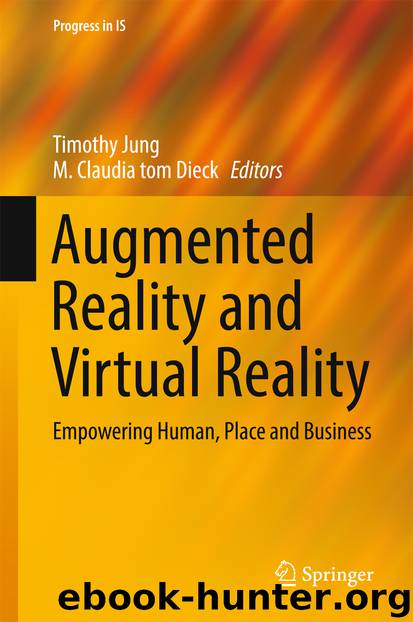Augmented Reality and Virtual Reality by Timothy Jung & M. Claudia tom Dieck

Author:Timothy Jung & M. Claudia tom Dieck
Language: eng
Format: epub
Publisher: Springer International Publishing, Cham
3.1 Internal Value Creation
Research and Development: Traditional research and development activities include a lot of investments into discovery and trial-and-error-processes. This is usually linked with a high investment into hardware such as printers, and into product concepts, usually done with different approaches to prototyping. Even though nowadays 3D printers are becoming more and more prevalent in use, this is still a high investment in terms of financial and time resources. With the use of ARSGs, these processes can be virtualized by using 3D applications—and it even goes further through the usage of social media for the evaluation of new product ideas. Hence, such devices can foster and facilitate the full innovation process within a company and its research and development activities.
Beyond that, ARSGs offer new methods of market research for firms. Consider, for example, survey applications that cover physical information—such as a product or a store—and integrated surveys. Extended versions of ARSGs could combine the advantages of mobile surveys and eye-tracking (as well as other forms of observational data) and provide marketers with new methods and enhanced results/outcomes of market research. Prior research has also focused on new technologies for product testing. For example, the use of virtual 3D-screens have been investigated as a means to test packaging and display its benefits compared to 2D-tests with the limitation of artificial laboratory situations (Berneburg 2007). ARSGs could also be used to present products more realistically. For example, new forms of a bottle could be virtually displayed on a respondent’s dining table at home and evaluated in a realistic situation, thus increasing the external validity of product tests.
Collaboration: Early attempts have been made to use ARSGs as a means to promote collaborative work. For instance, Muensterer and colleagues tested the acceptance of Google Glass in a pediatric hospital and used it for telemonitoring with colleagues all over the world (Muensterer et al. 2014). Similarly, manufacturers of ARSGs, such as Microsoft (2015), highlight the benefits of collaborations with varied examples—in a personal setting (a father, who from distance, helps his daughter fix a drain at home) or in a professional setting (researchers in a lab analysing rocks on Mars). Likewise, collaborations in customer-firm interactions are possible, for example, for functions such as customer service and product support. Finally, virtual meetings through services like Skype can be much more efficient if additional information can be shared in real-time and with full visibility through ARSGs. The movie Kingsman provides several fictitious examples how ARSGs can enhance conferences by augmenting conversation partners into a conference room.
Process Effectiveness: Using ARSGs at work could increase an employee’s efficiency, as information is always accessible. This is possible, as in times of big data, digitalization, and the ‘Internet of Things’, products and systems can communicate autonomously with each other and provide employees with relevant information (Lee and Lee 2015). The advantages of ARSGs compared to other forms of devices are threefold: First, only relevant information is displayed. For example, a cook can exclusively take a look at the information about
Download
This site does not store any files on its server. We only index and link to content provided by other sites. Please contact the content providers to delete copyright contents if any and email us, we'll remove relevant links or contents immediately.
Blood, Sweat, and Pixels by Jason Schreier(3566)
Godot 4 Game Development Cookbook by Jeff Johnson(2859)
Dawn of the New Everything by Jaron Lanier(2738)
The Art of Doom by Bethesda(2108)
Significant Zero by Walt Williams(1929)
Creative Character Design by Bryan Tillman(1888)
Art Of Atari by Tim Lapetino(1750)
World of Warcraft Chronicle Volume 3 by Blizzard Entertainment(1707)
The Ultimate Roblox Book by David Jagneaux(1657)
Mission Python by Sean McManus(1655)
Pillars of Eternity Guidebook by Obsidian Entertainment(1625)
Dawn of the New Everything: Encounters with Reality and Virtual Reality by Jaron Lanier(1578)
Unreal Engine 4 Virtual Reality Projects by Kevin Mack(1527)
1628927445Game by Unknown(1524)
Unreal Engine Virtual Reality Quick Start Guide by Jessica Plowman(1513)
Learning D by 2015(1490)
The Ultimate Player's Guide to Minecraft by Stephen O'Brien(1489)
Unity 2018 By Example by Alan Thorn(1430)
Road Games by Road Games(1416)
